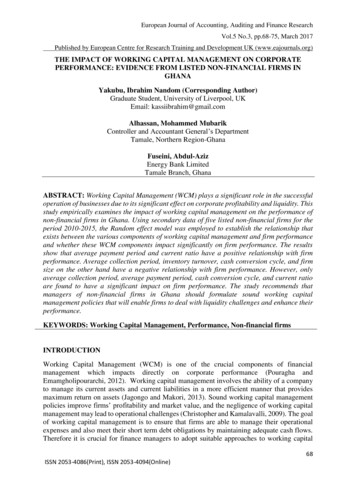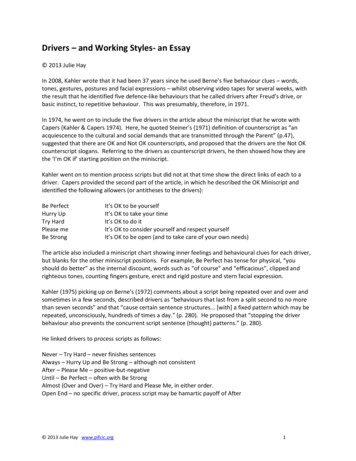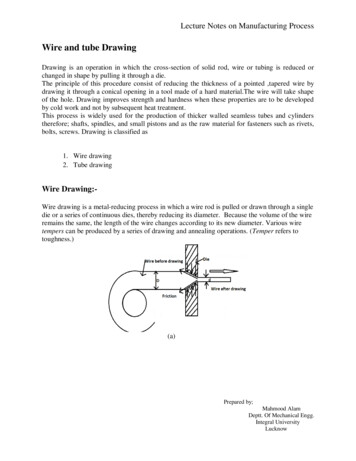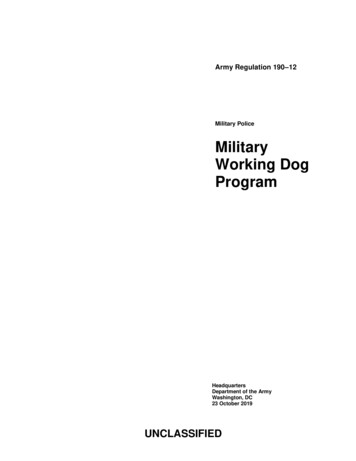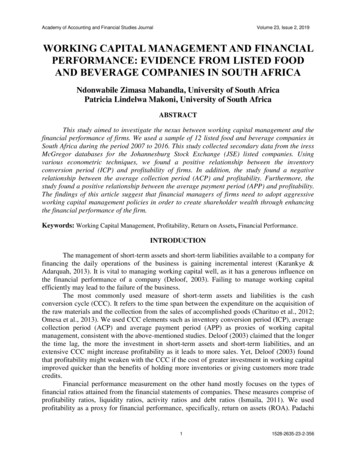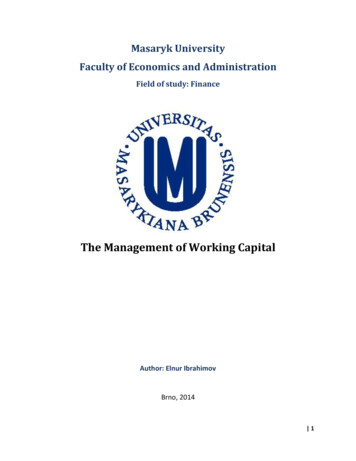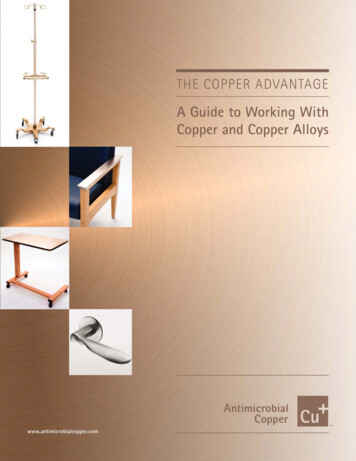
Transcription
THE COPPER ADVANTAGEA Guide to Working WithCopper and Copper Alloyswww.antimicrobialcopper.com
CONTENTSI.Introduction .Conductivity .Strength.Formability .Joining .Corrosion .Copper is Antimicrobial .Color .Copper Alloy Families .344444455II. Physical Properties . 8Properties . 8Electrical & Thermal Conductivity . 8III. Mechanical Properties . 12Tensile Properties . 12IV. Chemical Properties. 15Biological Importance . 15Color & Tarnishing . 16Corrosion Resistance . 16Stress Corrosion . 17V. Antimicrobial Behavior . 18EPA Testing . 18Clinical Trials . 19Stipulations . 19VI. Working With Copper Alloys . 20Commercial Product Forms . 20Hot Forming Processes . 21Extrusion . 21Forgings. 21Cold Forming Processes . 21VII. Joining . 23Soldering & Brazing. 23Flameless Joining . 24CuproBraze . 24Welding . 25Metallurgical Bonding . 25Mechanical Fasteners . 26Adhesive Bonding . 26VIII. References . 27PREFACEThe information in this guide includes an overview of the wellknown physical, mechanical and chemical properties of copper,as well as more recent scientific findings that show copper hasan intrinsic antimicrobial property. Working and finishingtechniques, alloy families, coloration and other attributes areaddressed, illustrating that copper and its alloys are soadaptable that they can be used in a multitude of applicationsin almost every industry, from door handles to electricalcircuitry to heat exchangers.Copper’s malleability, machinability and conductivity havemade it a longtime favorite metal of manufacturers andengineers, but it is its antimicrobial property that will extendthat popularity into the future. This guide describes thatproperty and illustrates how it can benefit everything fromcommon touch surfaces to HVAC coils.History is rich with evidence of copper’s biocidal ability.For example, the ancient Egyptians, Greeks, Romans andAztecs used copper compounds for the treatment of disease andgood hygiene and, much later, the hulls of British naval shipswere encased in copper to protect against biofouling. In supportof the historical anecdotal evidence, recent laboratory testinghas shown that copper and copper alloys are effectiveantimicrobial materials.Copper, brass and bronze work effectively against the mosttroublesome antibiotic-resistant bacteria* including Methicillinresistant Staphylococcus aureus (MRSA) and Vancomycinresistant enterococcus (VRE), as well as other commonharmful bacteria*.Copper is the only solid surface material registered by theU.S. Environmental Protection Agency to continuously killbacteria* that pose a threat to human health. No other touchsurface material has this kind of registration.This booklet will serve to answer immediate questionsabout using copper and copper alloys in familiar ways and innew applications, as well as guide the reader to sources ofmore in-depth information.* Laboratory testing shows that, when cleaned regularly, Antimicrobial Copper killsgreater than 99.9% of the following bacteria within 2 hours of exposure: Methicillinresistant Staphylococcus aureus (MRSA), Vancomycin-resistant enterococcus faecalis(VRE), Staphylococcus aureus, Enterobacter aerogenes, Pseudomonas aeruginosa, and E.coli O157:H7. Antimicrobial Copper surfaces are a supplement to and not a substitute forstandard infection control practices. Like other antimicrobial products, they have beenshown to reduce microbial contamination, but do not necessarily prevent cross contamination; users must continue to follow all current infection control practices.
I. INTRODUCTIONCopper and copper alloys are widely used in a variety of products that enable and enhance our everyday lives. They haveexcellent electrical and thermal conductivities, exhibit good strength and formability, have outstanding resistance tocorrosion and fatigue, and are generally nonmagnetic. They can be readily soldered and brazed, and many can be weldedby various gas, arc and resistance methods. They can be polished and buffed to almost any desired texture and luster. Purecopper is used extensively for electrical wire and cable, electrical contacts and various other parts that are required to passelectrical current. Coppers and certain brasses, bronzes and copper nickels are used extensively for automotive radiators,heat exchangers, home heating systems, solar collectors, and various other applications requiring rapid conduction of heatacross or along a metal section. Because of their outstanding ability to withstand corrosion, coppers, brasses, bronzes andcopper nickels are also used for pipes, valves and fittings in systems carrying potable water, process water or otheraqueous fluids, and industrial gases.Copper alloys are also ideally suited where it is important to minimize bacterial* levels on touch surfaces. Because oftheir inherent ability to kill 99.9% of bacteria* within two hours, more than 280 copper alloys have been granted publichealth registration by the U.S. Environmental Protection Agency (EPA). This unprecedented registration recognizescopper’s inherent ability to continually kill bacteria* between regular cleanings, and aids in reducing infection-causingbacteria* on touch surfaces in hospitals, schools, offices and other public establishments.3
ConductivityJoiningOf all common metals, copper possesses the highest ratingfor both electrical and thermal conductivity. High conductivity coupled with intrinsic strength, formability and corrosionresistance make copper alloys unique as conductors ofelectricity – making them ideal for connectors and otherelectrical/electronic products.Copper and copper alloys can be easily joined by thecommon methods – soldering, brazing, welding, bolting,riveting, crimping and adhesive bonding. The installation ofplumbing fixtures and components provide examples oftypical soldering and brazing applications. Weldingtechniques are routinely used for copper and copper nickelwelded tube used in water delivery systems, heat exchangersand air-conditioning units. Additional information is foundin Section VII of this publication.CorrosionStrengthCopper is a relatively soft and malleable metal with excellent formability, making it ideal for architectural applications such as roofs, wall cladding, gutters and downspouts.Additions of other elements to copper strengthen it andform copper alloys, including brasses, phosphor bronzesand copper nickels. Copper alloys possess tensile propertiesthat exceed some aluminum alloys and approach those ofstainless steels, and can be used in a multitude of applications. Miniaturization of electronic devices and componentshas benefited from the high strength and moderate to highconductivities offered by specialty copper alloys.FormabilityCopper’s exceptional formability is most readily illustratedby its ability to produce micron-sized wire with minimumsoftening anneals. In general, copper alloys exhibitincreased strength proportional to the amount and the natureof the alloying element. In brasses, bronzes, nickel silvers,copper nickels and other alloy families, strength is increasedin proportion to the amount of cold work. Deep drawing,coining, stretching, and bending are common methods usedto form components such as bathroom fixtures and otherhousehold products. Cartridge brass reflects the deepdrawing characteristic of that alloy. Copper nickel tubes aregenerally formed from strip and then custom installed ascondenser bundles.4Copper and its alloys are widely used in many environmentsand applications because of their excellent corrosion resistance. Architectural fittings and fixtures made from copper,brass and bronze continue to provide service in both indoorand outdoor environments. Copper alloys corrode at negligible rates in unpolluted air, water and deaerated nonoxidizing acids. Many copper alloy artifacts have been found innearly pristine condition after having been buried in theearth for millennia. Copper roofing has been found to corrode at rates of less than 0.015 in (0.4mm) in 200 years.Copper alloys resist many saline solutions, alkaline solutions and organic chemicals.Typical applications where copper and copper alloysprovide superior service include indoor and outdoor architectural components, freshwater supply lines and plumbingfixtures, heat exchangers and condensers, freshwater andseawater marine hardware, industrial and chemical plantprocess equipment, electrical wire and cable, printed circuitboards and industrial products.Copper is AntimicrobialThe antimicrobial attributes of copper and its alloys areintrinsic and have been exploited for centuries. Egyptiansused copper drinking vessels to clean water. TheHippocrates Collection, 460 to 380 B.C., recommends theuse of copper for leg ulcers related to varicose veins. Plinythe Elder, A.D. 23 to 79, used copper oxide with honey totreat intestinal worms. The Aztecs gargled with a mixturecontaining copper to treat sore throats.Recent independent laboratory testing led the EPA toregister copper alloys for their inherent ability to kill 99.9%of the following listed organisms within two hours:Vancomycin-resistant enterococci (VRE), Staphylococcusaureus, Enterobacter aerogenes, Escherichia coli O157:H7,Pseudomonas aeruginosa and Methicillin-resistantStaphylococcus aureus (MRSA). No other solid metalsurfaces have EPA registration to make public health claims.
Widely publicized statistics from the Centers forDisease Control and Prevention (CDC) estimate infectionsacquired in U.S. hospitals affect two million individualsevery year and result in nearly 100,000 deaths annually.Results from a clinical trial in Birmingham, England,demonstrate that the use of copper alloys on certain surfacesin a busy hospital ward has the pot ential to reducemicrobial contamination compared to non-copper surfaces.ColorVariations in the color of copper alloys stem primarily fromdifferences in chemical composition. Unalloyed coppershave a red tone. The addition of other elements causes achange toward yellow, bronze, silver or gray. These colorscan then develop patinas when exposed to air. The degree ofchange depends upon the alloy chemistry and the composition of the atmosphere.Copper Alloy FamiliesCopper alloys are identified by the Unified NumberingSystem (UNS) which categorizes families of alloys basedupon their elemental make-up. Wrought products range fromUNS C10000 through UNS C79999; cast products areassigned numbers between UNS C80000 and UNS C99999.TABLE 1: UNS Copper Alloy DesignationsCopper in its pure, unalloyed state is soft, provides highelectrical and thermal conductivity and has excellent corrosion resistance. There are various grades of unalloyed copper, which differ in the amount of impurities they contain.Oxygen-free coppers are used specifically in applicationsrequiring high conductivity and exceptional ductility.Brasses are alloys made from copper and zinc, they exhibitgood strength and ductility and are easily cold worked,properties which improve with increased zinc content upto 35%. Brass coloration ranges from red to golden yellow,depending on the amount of zinc the alloy contains.Gilding Metal, Commercial Bronze, Jewelry Bronze,Red Brass and Cartridge Brass are common names givento brass alloys with specific zinc contents.Brasses containing between 32% and 39% zinc exhibitexcellent hot working characteristics but limited cold workability. Brasses containing more than 39% zinc, such asMuntz Metal, have high strength and lower ductility at roomtemperature than alloys with less zinc.Brasses are known for their ease of fabrication by drawing, high cold-worked strength and corrosion resistance.Brasses are routinely blanked, coined, drawn and pierced toproduce springs, fire extinguishers, jewelry, radiator cores,lamp fixtures, ammunition, flexible hose and the base forgold plate. Brasses have excellent castability. Cast brassesare used as plumbing fixtures, decorative hardware, architectural trim, low pressure valves, gears andbearings.AL L O YW RO UG HTCASTCopperC10100 to C13000C80100 to C81200BrassC20500 to C28580C83300 to C85800Tin BrassC40400 to C48600C83300 to C84800Phosphor BronzeC50100 to C52400C90200 to C91700Aluminum BronzeC60800 to C64210C95200 to C95900Silicon BronzeC64700 to C66100C87000 to C87999Silicon Red BrassC69400 to C69710C87300 to C87900Copper NickelC70100 to C72950C96200 to C96900Nickel SilverC73500 to C79900C97300 to C97800Tin Brasses are alloys made from copper, zinc(2% to 40%) and tin (0.2% to 3%). This family of alloys includes admiralty brasses, navalbrasses and free-machining tin brasses. Thesealloys are used to make high-strength fasteners, electrical connectors, springs, corrosionresistant mechanical products, marine hardware, pump shafts, and corrosion-resistantscrew machine parts. They provide increasedcorrosion resistance, lower sensitivity to dez-5
incification and higher strength compared with straightbrasses. They possess good hot forgeability and good coldformability. These materials have moderate strength, highatmospheric and aqueous corrosion resistance and excellentelectrical conductivity.Silicon Bronzes are part of the subgroup of high-strengthbrasses. They contain less than 20% zinc and up to 6% silicon and are solid solution strengthened. Silicon red brassesare used for valve stems where corrosion resistance andhigh strength are critical. Included in this category are thesilicon red bronzes, which are similar to silicon red brassesexcept for their very low concentrations of zinc. They areused to make bearings, gears and intricately shaped pumpand valve components.Nickel Silvers, also called nickel brasses, are alloys containing copper, nickel, and zinc. Though they do not containsilver, they have an attractive silver luster, moderately highstrength and good corrosion resistance. They are used tomake food and beverage handling equipment, decorativehardware, electroplated tableware, optical and photographicequipment and musical instruments.Copper Nickel alloys contain anywhere from 2% to 30%nickel, are highly corrosion-resistant and thermally stable.The addition of iron, chromium, niobium and/or manganesecan improve their strength and corrosion resistance. Theyare virtually immune to stress corrosion cracking and exhibit high oxidation resistance in steam and moist air. The higher nickel alloys are well known for their corrosion resistancein sea water as well as resistance to marine biofouling. Theyare used to make electrical and electronic products, tubes forcondensers in ships, on offshore platforms and in powerplants, and various other marine products including valves,pumps, fittings and sheathing for ship hulls.Phosphor Bronzes, or tin bronzes as they are sometimescalled, contain between 0.5% and 11% tin and 0.01% to0.35% phosphorous. Tin increases their corrosion resistanceand tensile strength; phosphorous increases wear resistanceand stiffness. Phosphor bronzes have superb spring qualities, high fatigue resistance, excellent formability and solderability, and high corrosion resistance. They are used primarily for electrical products; other uses include corrosionresistant bellows, diaphragms and spring washers.TABLE 2: Compositions & Properties of the More Common Copper AlloysALLOYUNSNo.N O M IN ALCO M PO SIT IO NWt%E L E CT R ICALCO N D U CT IVIT Y%IACST E N SIL EST R E N G T HKsi ( M Pa )99 min Cu10142 (290)C11000CopperC12200Phosphorus Deoxidized Copper0.025 P8542 (290)C17200Beryllium Copper1.90 Be22128 (882)**C23000Red Brass15 Zn3756 (386)C26000Cartridge Brass30 Zn2862 (427)C28000Muntz Metal40 Zn2870 (483)C42500Tin Brass10 Zn – 2 Sn2863 (434)C51000Phosphor Bronze A5 Sn – 0.2 P1568 (469)C52400Phosphor Bronze D10 Sn – 0.2 P1183 (572)C65500High Silicon Bronze A3.3 Si – 1.0 Mn778 (537)C70600Copper Nickel, 10%10 Ni – 1.4 Fe965 (448)C71500Copper Nickel, 30%30 Ni – 0.7 Fe4.673 (503)C74500Nickel Silver, 65-1025 Zn – 10 Ni973 (503)C75200Nickel Silver, 65-1817 Zn – 18 Ni674 (510)* H02, 1/2 Hd Temper** Mill Hardened, TMO26COMMON NAME*
Aluminum Bronzes contain 6% to 12% aluminum, up to6% iron and nickel and provide high strength and excellentcorrosion and wear resistance. Solid solution strengthening,cold work and precipitation of an iron rich phase contributeto these characteristics. High aluminum containing alloyscan be quenched and tempered. Aluminum bronzes are usedin marine hardware, shafts and pump and valve componentsfor handling seawater, sour mine waters, nonoxidizingacids, and industrial process fluids. They are also used asheavy duty sleeve bearings and machine tool ways.Aluminum bronze castings have exceptional corrosionresistance, high strength, toughness and wear resistance.They also exhibit good casting and welding characteristics.precipitation hardening capability. Their high strength coupled with good formability, thermal stability and electricalconductivity make them appropriate for use in electricaland electronic connectors and hardware. These alloys havedesignations throughout the UNS system based upon theircomposition.As we have seen, copper and its alloys constitute a broadrange of chemical compositions and are employed widelyin applications that enable and enhance our everyday lives.Each application makes effective use of copper’s attributes:strength, conductivity, color, formability, joinability andthermal stability.Specialty Copper Alloys, based, for example, on the copper-nickel-silicon and copper-nickel-tin systems, provideunique combinations of properties due to their intrinsic7
II. PHYSICAL PROPERTIESPropertiesCopper, atomic number 29 with an atomic weight of 63.54, exhibits a face-centered cubic crystal structure. Copper is atransitional element and, being a noble metal, it has inherent properties similar to those of silver and gold. Its excellentconductivity, malleability, corrosion resistance and biofunctionality stem from copper’s elemental origins. Copper hasa high solubility for other elements such as nickel, zinc, tin and aluminum. This solid solution alpha (α) phase isresponsible for the high ductility exhibited by copper alloys. Alloying additions beyond the solubility limit result in the beta(β) phase, which exhibits a body-centered cubic (bcc) structure. This β phase has high temperature stability, and alloys thatexhibit an α β structure have excellent hot forming capability.The density of copper is 0.321 lb/in² (8.89 g/cc), and its melting point is 1981 F (1083 C). All of these properties andcharacteristics are significantly modified when copper is alloyed. Table 3 lists the common physical properties of copper.The physical properties of five common wrought copper alloys are compared in Table 4.The periodic table shown in Figure 1 highlights copper and its common alloying elements.Electrical & Thermal ConductivityConductivity is the primary characteristic that distinguishes copper from other metals. The electrical conductivity ofmaterials is measured against that of a standard bar of “pure” copper that in 1913 was assigned a value of 100% IACS(International Annealed Copper Standard). Since that time, improved processing techniques and higher purity ingots haveresulted in commercial copper with electrical conductivity values slightly above 100% IACS.8
The thermal and mechanical processing variations usedto produce commercial alloys can cause profound changesin their conductivity, and frequently the alloys with thehighest strengths have the lowest conductivity. The IACSvalues are usually published as minimum values forannealed tempers. Tempered (cold-worked) products mayhave a value 1 to 5 percentage points below the annealedvalue. The drop in electrical conductivity with cold workis illustrated by Figure 2, where the electrical conductivityof the fully annealed and heavily cold drawn conditions ofcopper and copper-zinc wire samples are shown.Alloys of higher electrical resistivity (R) will wastemore energy, since heat generated due to an electric current(I) is proportional to I2 times the resistance. The heat generated will increase the temperature of the component, withpotentially adverse consequences. Higher thermal conductivity alloys allow the designer to dissipate some of thatheat, minimizing any temperature rise.Within alloy families, thermal conductivity tends to berelated to electrical conductivity; i.e., alloys of higher elec-trical conductivity will tend to have higher thermal conductivity. This rule of thumb is convenient since thermal conductivity is rather difficult to measure, while electrical conductivity, or its inverse, electrical resistivity, is easy to measure. The nearly linear relationship between thermal andelectrical conductivity at 68 F (20 C) is shown by Figure 3for selected copper alloys.TABLE 3: Physical Properties of CopperM ETR I CEN G LI SHPR O PE RT YVALU EU N I TSVALU EAtomic Number29Atomic Weight63.54U NITSDensity0.322lb/in38.92g/cm3Melting Point1981 F1083 CBoiling Point4703 F2595 C88Btu/lb205J/g9.33 x 10-6in/in F16.8 x 10-6cm/cm C0.09210.0939Btu/lb FBtu/lb F0.3860.393J/g CJ/g C227223Btu ft/ft2hr FBtu ft/ft2hr F3.943.85Wcm/cm2 CWcm/cm2 C100 - 101.597.0%IACS%IACS58.0 - 58.956.3MS/m(mΩmm2)MS/m(mΩmm2)Electrical Resistivity (Volume) at:68 F (20 C) Annealed68 F (20 C) Fully Cold Worked0.6788 - 0.6690.700µΩ·inµΩ·in1.7241 - 1.701.78µΩ·cmµΩ·cmModulus of Elasticity (Tension) at:68 F (20 C) Annealed17 x 103Ksi118,000MPaModulus of Rigidity (Torsion) at: 20 C:68 F (20 C) Annealed6.4 x 103Ksi44,000MPaLatent Heat of FusionLinear Coefficient of Thermal Expansion at:77 F - 212 F (25 C - 100 C)Specific Heat (Thermal Capacity) at:68 F (20 C)212 F (100 C)Thermal Conductivity at:68 F (20 C)212 F (100 C)Electrical Conductivity (Volume) at:68 F (20 C) Annealed68 F (20 C) Fully Cold Worked9
Most coppers used for electrical transmission and interconnection have electrical conductivity of 85% IACS orgreater. Commercially pure copper has 101% IACS as doseveral of the oxygen free (pure) coppers like C10100 andC10200. Note the conductivity of Phosphorous DeoxidizedCopper; it has a copper content of 99.9%, yet its conductivity is “only” 85% IACS. Phosphorous is one of the elementsthat severely depresses conductivity.The range of conductivity of copper alloys differs,depending on the alloying elements. High copper alloysmade with tellurium, zirconium, magnesium, chromium, andiron provide increased strength with conductivity in the 75%to 90% range. Another alloy group, with combinations ofelements including boron, iron, tin, zinc, cobalt, magnesiumand phosphorous, provides good strength with conductivityin the range of 50% to 75% IACS.Certain beryllium coppers, brasses, tin brasses, phosphor bronzes and copper-silicon alloys range from 25% to50% IACS conductivity.High-strength beryllium coppers, copper-nickel-siliconand copper-nickel-tin alloys, which can be strengthened byprecipitation hardening, provide very high strength with lowto medium electrical conductivity in the range from 10% to25% IACS. Recent development of alloys in these categories have optimized high strength with conductivities of 50% IACS.FIGURE 1: Periodic Table of Elements Showing Copper & Its Common Alloying ElementsAtomic Element’s NameAtomic WeightBeHeCu4Li229Element Symbol1.00794Common Alloying [257][258][259][262]118
FIGURE 2: Electrical Conductivity of the Annealed & the HeavilyDrawn Condition of Copper and Copper-Zinc Wire SamplesFIGURE 3: Relationship Between Thermal & ElectricalConductivity for Selected Copper AlloysElectrical Conductivity, Ms/m60.911.625034.846.452.290Cold Worked49.385Thermal Conductivity, Btu ft / ft2 hrºFAnnealedElectrical Conductivity, Electrical Conductivity, % 000C70600C7520001.0020Zinc Content, Wt%406080Thermal Conductivity, Wcm/cm2 · C105100Electrical Conductivity, % IACSTABLE 4: Physical Properties of Five Common Wrought Copper AlloysALLOYUNSNoDENSITYlb / in 3(g / cm 3 )MELTING POINT(or SOLIDUS)ºF (ºC)ELECTRICALCONDUCTIVITY%IACS (MS / m)THERMALCONDUCTIVITYBtu ft / ft 2 hr ºF( Wcm / cm 2 ºC)THERMAL EXPANSIONCOEFFICIENT (Linear)X10 -6 in / in ºF(X10 -6 cm / cm ºC)C110000.322 (8.92)1949(1065)101 (58)226(3.94)9.33(16.8)C260000.308 (8.53)1680(915)28 (16)70(1.21)11.1(19.9)C510000.320 (8.86)1750(950)15 (8.7)40(0.71)9.9(17.8)C706000.323 (8.94)2010(1100)9 (5.2)26(0.46)9.5(17.1)C752000.316 (8.73)1960(1070)6 (3.5)19(0.33)9.0(16.2)11
III. MECHANICAL PROPERTIESCopper is well-known to be a soft, malleable metal. Copper alloys, however, offer a wide variety and combination ofmechanical properties that reflect a degree of adaptability not available in other alloy systems. Copper and high copperalloys are used extensively for cables, wires, electrical contacts and a multitude of other components that carry electricalcurrent. These applications demand low to moderate tensile strength with moderate thermal stability or stress relaxationresistance. Alloys with a finely dispersed second phase, which provides grain refinement, are selected to maximizestrength, ductility and conductivity.Many brasses, bronzes and copper nickels are used extensively for automotive radiators, heat exchangers, homeheating systems and other applications requiring rapid conduction of heat. They are chosen to provide higher strengthscoupled with ease of fabrication. The highest strength and stress relaxation resistance characteristics, which are demandedby electronic connectors, are offered by the precipitation strengthened alloys. Examples of temper designations used tospecify the condition of commercial copper alloys are listed in Table 5.Tensile PropertiesCopper alloys are primarily strengthened by cold work or by solid solution additions that enhance strain hardening.In the annealed condition, the yield and tensile strength vary inversely with grain size. The addition of alloying elementsto copper increases tensile strength, yield strength and the rate of work hardening. For example, in brasses, the tensilestrength and yield strength both increase as the zinc content increases.Different alloying elements vary in their effectiveness at increasing strength and work hardening, thus providinga spectrum of property combinations. The tensile property data in Table 6 illustrate the rolled temper effect (increasingcold work) in brass alloy C26000. The role of zinc content on rolled temper tensile properties is illustrated by data inTable 7, showing tensile properties of various brass alloys in the H02 or half-hard temper.12
The cold rolling curves in Figure 4 illustrate the effectof work hardening on the tensile properties of annealed,or soft, brass alloy C26000. The ultimate tensile and yieldstrengths increase, while the ductility and tensile elongationdrops with cold rolling reduction. The cold rolling curves inFigure 5 show the increasing tensile strength wit
for both electrical and thermal conductivity. High conductiv-ity coupled with intrinsic strength, formability and corrosion resistance make copper alloys unique as conductors of electricity – making them ideal for connectors and other electrical/electronic products. Strength Co



